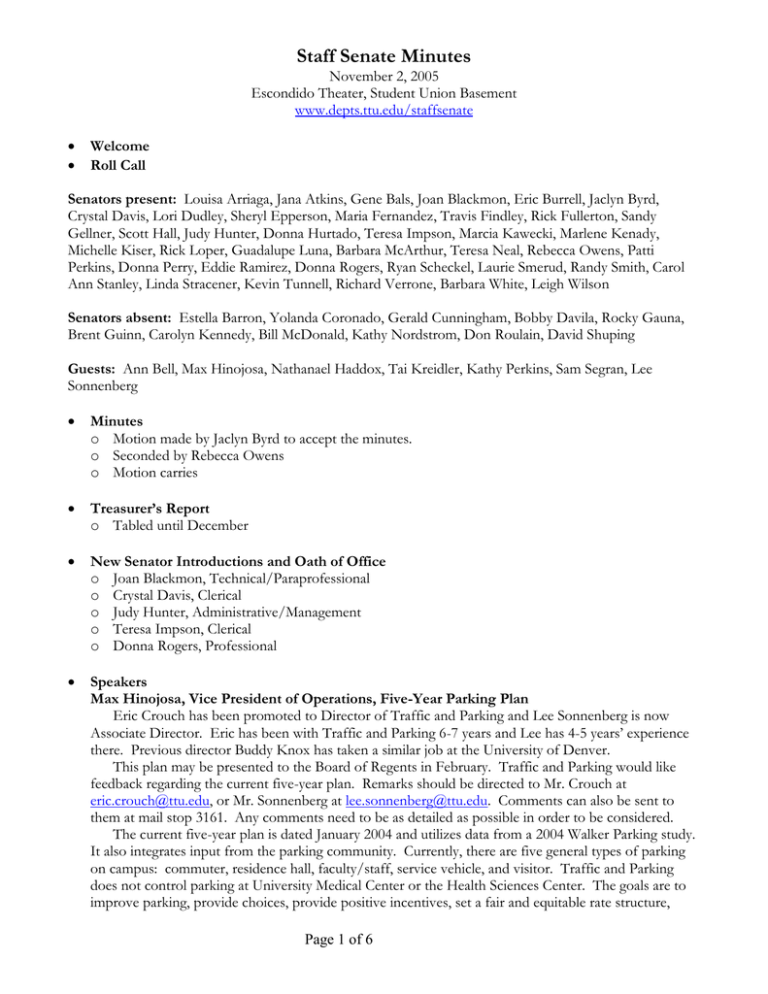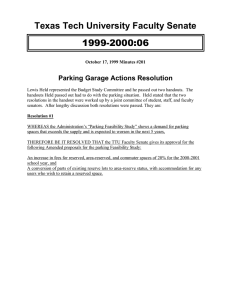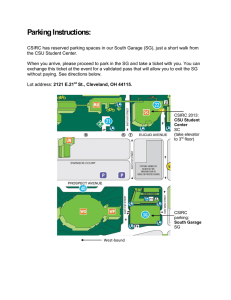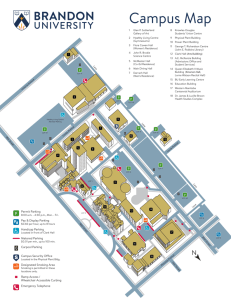Staff Senate Minutes
advertisement

Staff Senate Minutes November 2, 2005 Escondido Theater, Student Union Basement www.depts.ttu.edu/staffsenate Welcome Roll Call Senators present: Louisa Arriaga, Jana Atkins, Gene Bals, Joan Blackmon, Eric Burrell, Jaclyn Byrd, Crystal Davis, Lori Dudley, Sheryl Epperson, Maria Fernandez, Travis Findley, Rick Fullerton, Sandy Gellner, Scott Hall, Judy Hunter, Donna Hurtado, Teresa Impson, Marcia Kawecki, Marlene Kenady, Michelle Kiser, Rick Loper, Guadalupe Luna, Barbara McArthur, Teresa Neal, Rebecca Owens, Patti Perkins, Donna Perry, Eddie Ramirez, Donna Rogers, Ryan Scheckel, Laurie Smerud, Randy Smith, Carol Ann Stanley, Linda Stracener, Kevin Tunnell, Richard Verrone, Barbara White, Leigh Wilson Senators absent: Estella Barron, Yolanda Coronado, Gerald Cunningham, Bobby Davila, Rocky Gauna, Brent Guinn, Carolyn Kennedy, Bill McDonald, Kathy Nordstrom, Don Roulain, David Shuping Guests: Ann Bell, Max Hinojosa, Nathanael Haddox, Tai Kreidler, Kathy Perkins, Sam Segran, Lee Sonnenberg Minutes o Motion made by Jaclyn Byrd to accept the minutes. o Seconded by Rebecca Owens o Motion carries Treasurer’s Report o Tabled until December New Senator Introductions and Oath of Office o Joan Blackmon, Technical/Paraprofessional o Crystal Davis, Clerical o Judy Hunter, Administrative/Management o Teresa Impson, Clerical o Donna Rogers, Professional Speakers Max Hinojosa, Vice President of Operations, Five-Year Parking Plan Eric Crouch has been promoted to Director of Traffic and Parking and Lee Sonnenberg is now Associate Director. Eric has been with Traffic and Parking 6-7 years and Lee has 4-5 years’ experience there. Previous director Buddy Knox has taken a similar job at the University of Denver. This plan may be presented to the Board of Regents in February. Traffic and Parking would like feedback regarding the current five-year plan. Remarks should be directed to Mr. Crouch at eric.crouch@ttu.edu, or Mr. Sonnenberg at lee.sonnenberg@ttu.edu. Comments can also be sent to them at mail stop 3161. Any comments need to be as detailed as possible in order to be considered. The current five-year plan is dated January 2004 and utilizes data from a 2004 Walker Parking study. It also integrates input from the parking community. Currently, there are five general types of parking on campus: commuter, residence hall, faculty/staff, service vehicle, and visitor. Traffic and Parking does not control parking at University Medical Center or the Health Sciences Center. The goals are to improve parking, provide choices, provide positive incentives, set a fair and equitable rate structure, Page 1 of 6 strive for one space-one bed ratio, and improve effectiveness of the bus system. (One space-one bed ratio applies to residence hall parking and means for every bed in the residence halls, there is one parking space available.) 2005-2006: The department achieved 300 new commuter spaces, 167 new residence hall spaces, and 1,500 new satellite spaces to replace 900 that were lost to construction. No new faculty and staff parking has been added at this time. Spaces west of the Law may be able to be reinstated. There are no wait lists for parking at Carpenter and Murray residence halls. The new Experimental Sciences building provided 62 new parking spaces. 2006-2007: Approximately 300 commuter spaces will be reclaimed from the remnants of C8 and C9. The Law School expansion will probably require some additional parking. Extended Studies will move to a new building on campus. 2007-2008: Garage II construction is planned and ties into the new College of Business Administration (COBA) building. This will be located in the southeast corner, in place of the current Women’s Gym. More parking is needed in this area due to the increased traffic in the Student Union in the evenings as well as increased programming in the performing arts departments. 200 spaces in the new garage would be dedicated to COBA. The building will be funded 50% with tuition revenue bonds and 50% with donations, which is causing a delay in starting construction. 2008-2009: Garage II should be complete and will contain 600 commuter spaces, 240 residence hall spaces, 200 faculty/staff spaces, and the remainder will be paid visitor spaces. Gaston/Thompson Hall is on the demolition list. A new student wellness center is planned. Additional commuter or faculty/staff parking may be added. 2009-2010: Approximately 250 commuter spaces are planned south of the International Cultural Center. Over the life of this plan, 3,717 total spaces should be added, with 3,357 of those dedicated to students. The student population has grown every year, and moving Tech to the next level will require more parking for student and faculty growth. It will be possible to build parking on the north side of Brownfield Highway. There is also a plan to relandscape the Administration lot. This will eliminate some parking in that lot, but landscaping and safety would be improved. For 2010-2015, the department has considered several locations for future parking garages on campus. Possible locations include: next to the United Spirit Arena, behind Stangel/Murdough, at the former Thompson Hall location, and behind Holden Hall. There has been some discussion about putting a parking lot on the east side of the football stadium which is not included in this plan. There is a good chance that most of that garage cost could be paid with game-day parking. Financing the plan will be accomplished through: price increases revenue from outside sources o event surcharges o federal grants o game day parking fees compromise solutions (park and pay lots can be expanded if necessary) 2006-2007 parking fees: A tiered fee schedule is being considered where the premium or most highly demanded spaces would cost more. Fee tiers would be designated as follows based on distance from the campus academic core: o garage o residence hall/area reserved o commuter north/west o commuter satellite Memorial Circle is used as the center of the academic core. Cost should also be connected to equity between employees and students. For example, a 9-month residence hall permit costs $146, as does a Page 2 of 6 12-month area-reserved space. Employees are generally only here 5 days per week for 8 hours a day, but all year. Students are generally here only 9 months, but their parking spaces are in constant use. Based on location, satellite commuter parking is the least expensive and represents the baseline from which other fees are set: Commuter permits will be reduced by $15. Residence hall permits and student garage permits will be increased to cover the cost of extended permit hours. Area-reserved and faculty/staff garage permits will be increased to create parity with student fees Reserved parking rates will reflect their premium nature. The chart below shows the current parking rates and the planned rates for fiscal year 2007. Fee Type1 FY06 Increase/ (Decrease) FY07 Adjustment Satellite $129 $96 ($33) Baseline Adjustment Commuter $174 $159 Residence Hall $196 $239 $43 50% more than Commuter Area Reserve $146 $199 $53 25% more than Commuter Student Garage Faculty/Staff Garage $393 $478 $281 $398 $85 2x surface parking. All permits will be in covered $117 parking. Faculty/Staff Reserved $421 $699 $278 Premium for convenience Faculty/Staff Garage Reserved $449 $898 $449 (Area Reserved + $500) ($15) 66% more than Satellite Other parking concerns: Buses will pass through the satellite parking areas approximately every eight minutes, and every four minutes for other parking areas. Reserved space holders will not be required to pay for temporary permits Area-reserve permit holders can request up to two temporary permits per year, and each temporary permit expires at a maximum of one week. All garage permits will be in covered parking. A Motorist Assistance program is available. The service is provided at no charge up to 3 times per year, but any charges for usage over that amount has not been assessed to anyone. A car checkup clinic is planned for 3 times per year. TTU staff mechanics and off-campus mechanics help with this service. This would be available to faculty and staff as well as to students. These are usually held just before Thanksgiving and Spring Break. The third clinic is planned for the end of the summer session. Another goal is to better maintain parking lots to avoid necessary repairs to employee/student cars. Comments and questions from the floor. A comment was made from the floor regarding productivity for employees who park on the outer perimeter, which would require more time away from the job to run errands or attend meetings that require the employee to use his or her personal vehicle. Campus mobility still Page 3 of 6 has not been addressed, and employees are not able to move efficiently from one campus location to another. There is no service vehicle parking. Traffic and parking will study how to maximize and increase small lots behind buildings for service parking and deliveries. The Residence Hall Association has not wanted parking enforced after 5:30 p.m. or on weekends, but some students work late and are unable to find parking spaces during these times of non-enforcement. If guaranteed parking is imposed for residence hall, this nonenforcement will not be able to continue. If employees are having to park in the outer perimeter, bus service would be continued during holidays and class breaks. If this plan is implemented for 2006-2007, employees with reserved spaces will be allowed to move to an area-reserve permit. The parking garage waiting list is a little over 1,000. Through town hall meetings and other venues, there are indications that many students would prefer to park in the garage to protect their vehicles. Garages are more costly to maintain than any other type of parking. The cost is distributed among all permits to keep the cost down. This new system moves away from this method. Parking permit revenue stays in the Traffic and Parking fund balance to pay for salaries and maintenance. Parking for football games can cost around $3000 per space per year. A garage would generate a lot of parking revenue. Faculty/staff doing research on game day cannot park in lots near the stadium. The Women’s Gym is also on the demolition list, so Garage II is planned for this location. Committee Reports o Bylaws (Jaclyn Byrd) First reading: Article IV Standing Committees A. Membership/Purpose. 2. Nominations/3. Elections/4. Grievance. See Appendix A for full text with changes. Comments – Some groups have small representation at the first meeting. It is allowable for senators to serve as an EEO representative and as a committee representative. If no members present at the meeting are willing to serve, the appointment could be made through the Nominations committee. There is a problem, though if the committee in question is the Nominations committee. The Constitution and Bylaws Committee will discuss this change again and present any necessary changes at the December meeting. o Communications/Public Relations (Randy Smith). The committee requests a vote today on the name for the newsletter. Ballots were passed out to senators. The committee also suggests creating this newsletter quarterly. The most recent Welcome Event went well. More volunteers from general Staff Senate are needed to attend these events. The next event is November 10 and is the last one this year. Patti Perkins volunteered to attend. o Issues (Donna Perry) The committee hasn’t met in the last month to discuss new issues. An ad hoc meeting will be held tomorrow at 3:30 p.m. to look at fall break issue. Rebecca Owens is lead researcher. The Staff Senate passed the hand washing resolution, but the Presidential Advisory Council decided instead to put out an informational letter to deans, directors, and department chairs for dissemination to other employees. A source from the Health Sciences Center says these placards are often defaced or removed, so they aren’t necessarily the best source of information. TechAnnounce could serve as another vehicle for this information and it can be added to the newsletter. o External Committees Page 4 of 6 Faculty Senate (Rebecca Owens) On-campus day care was discussed at the last meeting. The Staff Senate has researched this issue in the past. It was suggested that the various Senates can work together for more emphasis. Tuition for 2006-2007 was discussed regarding best way to raise tuition for 2006-2007, but not too much. The suggestion was to raise tuition $5 per credit hour across-the-board to cover a few areas of deficit. Skyrocketing electric bills are the biggest budget issue at the moment. Increasing students and filling up classrooms equals more prestige for TTU. Jennifer Hammat, Managing Director of Student Judicial Programs says that TTU Staff has seats on the University Discipline Committee, University Discipline Appeals Committee, and the Student Conduct Committee. Currently, there are 10 empty slots on these committees and volunteers are requested. (These slots were filled by the end of today’s meeting.) The Gender Equity Committee met 2 weeks ago and broke into subcommittees dealing with work issues, work-climate issues, and family issues. President’s report: o Richard Verrone has received multiple requests from people wishing to speak at Staff Senate meetings. Speakers are lined up through the March meeting. o The Lubbock Avalanche-Journal plans to run a story in tomorrow’s issue about the tuition waiver for employees. According to President Whitmore, the Board of Regents supports this. Once the Finance Committee agrees, the full Board of Regents will make a decision on the issue. The program should begin in Spring 2006. o The Fall Break is still an issue. Nathan Nash will be invited to speak at a later date regarding this issue. Announcements o Please vote and wear your “I voted” sticker. o The Faculty/Staff dining plan is now available. You must obtain a plastic university ID card to use the dining plan. o Escondido Theater is a bad venue for Staff Senate meetings due to noise and lighting problems. Rebecca Owens is researching moving to another location until the Senate Room renovations are complete. o Lanie Dornier, Kay Whyburn Rhodes, and Eric Crouch plan to attend the December meeting. Adjourn o Motion made by Rebecca Owens to adjourn o Seconded by Scott Hall o Motion carries Page 5 of 6 Appendix A Bylaws Revisions First Reading Each of the committee descriptions contains the same wording regarding the membership of the committee. The wording for each description will be changed as follows: Article VI Standing Committees A. Membership/Purpose 2. Nominations/3. Elections/4. Grievance Original Respective committees “shall be comprised of one member from each EEO classification to be chosen within that category.” Revised: Respective committees “shall be comprised of one member from each EEO classification to be chosen by a majority vote of those members present of each EEO classification at the first regularly scheduled meeting of each year where official business is conducted.” Page 6 of 6



